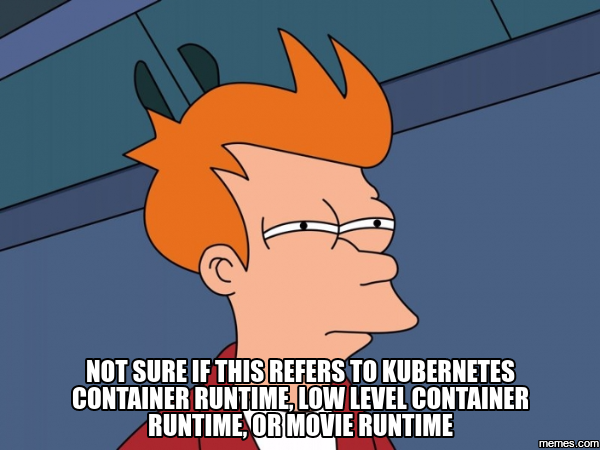Container Runtimes Part 1: An Introduction to Container Runtimes
One of the terms you hear a lot when dealing with containers is “container runtime”. “Container runtime” can have different meanings to different people so it’s no wonder that it’s such a confusing and vaguely understood term, even within the container community.
This post is the first in a series that will be in four parts:
- Part 1: Intro to Container Runtimes: why are they so confusing?
- Part 2: Deep Dive into Low-Level Runtimes
- Part 3: Deep Dive into High-Level Runtimes
- Part 4: Kubernetes Runtimes and the CRI
This post will explain what container runtimes are and why there is so much confusion. I will then dive into different types of container runtimes, what they do, and how they are different from each other.

Traditionally, a computer programmer might know “runtime” as either the lifecycle phase when a program is running, or the specific implementation of a language that supports its execution. An example might be the Java HotSpot runtime. This latter meaning is the closest to “container runtime”. A container runtime is responsible for all the parts of running a container that isn’t actually running the program itself. As we will see throughout this series, runtimes implement varying levels of features, but running a container is actually all that’s required to call something a container runtime.
If you’re not super familiar with containers, check out these links first and come back:
- What even is a container: namespaces and cgroups
- Cgroups, namespaces, and beyond: what are containers made from?
Why are Container Runtimes so Confusing?
Docker was released in 2013 and solved many of the problems that developers had running containers end-to-end. It had all these things:
- A container image format
- A method for building container images (
Dockerfile/docker build) - A way to manage container images (
docker images,docker rm <image>, etc.) - A way to manage instances of containers (
docker ps,docker rm <container>, etc.) - A way to share container images (
docker push/docker pull) - A way to run containers (
docker run)
At the time, Docker was a monolithic system. However, none of these features were really dependent on each other. Each of these could be implemented in smaller and more focused tools that could be used together. Each of the tools could work together by using a common format, a container standard.
Because of that, Docker, Google, CoreOS, and other vendors created the Open
Container Initiative (OCI). They then broke
out their code for running containers as a tool and library called
runc and donated it to OCI as a
reference implementation of the OCI runtime
specification.
It was initially confusing what Docker had contributed to OCI. What they contributed was a standard way to “run” containers but nothing more. They didn’t include the image format or registry push/pull formats. When you run a Docker container, these are the steps Docker actually goes through:
- Download the image
- Unpack the image into a “bundle”. This flattens the layers into a single filesystem.
- Run the container from the bundle
What Docker standardized was only #3. Until that was clarified, everyone had thought of a container runtime as supporting all of the features Docker supported. Eventually, Docker folks clarified that the original spec stated that only the “running the container” part that made up the runtime. This is a disconnect that continues even today, and makes “container runtimes” such a confusing topic. I’ll hopefully show that neither side is totally wrong and I’ll use the term pretty broadly in this blog post.
Low-Level and High-Level Container Runtimes
When folks think of container runtimes, a list of examples might come to mind; runc, lxc, lmctfy, Docker (containerd), rkt, cri-o. Each of these is built for different situations and implements different features. Some, like containerd and cri-o, actually use runc to run the container but implement image management and APIs on top. You can think of these features – which include image transport, image management, image unpacking, and APIs – as high-level features as compared to runc’s low-level implementation.
With that in mind you can see that the container runtime space is fairly complicated. Each runtime covers different parts of this low-level to high-level spectrum. Here is a very subjective diagram:

So for practical purposes, actual container runtimes that focus on just running containers are usually referred to as “low-level container runtimes”. Runtimes that support more high-level features, like image management and gRPC/Web APIs, are usually referred to as “high-level container tools”, “high-level container runtimes” or usually just “container runtimes”. I’ll refer to them as “high-level container runtimes”. It’s important to note that low-level runtimes and high-level runtimes are fundamentally different things that solve different problems.
Containers are implemented using Linux namespaces and cgroups. Namespaces let you virtualize system resources, like the file system or networking, for each container. Cgroups provide a way to limit the amount of resources like CPU and memory that each container can use. At the lowest level, container runtimes are responsible for setting up these namespaces and cgroups for containers, and then running commands inside those namespaces and cgroups. Low-level runtimes support using these operating system features.
Typically, developers who want to run apps in containers will need more than just the features that low-level runtimes provide. They need APIs and features around image formats, image management, and sharing images. These features are provided by high-level runtimes. Low-level runtimes just don’t provide enough features for this everyday use. For that reason the only folks that will actually use low-level runtimes would be developers who implement higher level runtimes, and tools for containers.
Developers who implement low-level runtimes will say that higher level runtimes like containerd and cri-o are not actually container runtimes, as from their perspective they outsource the implementation of running a container to runc. But, from the user’s perspective, they are a singular component that provides the ability to run containers. One implementation can be swapped out for another, so it still makes sense to call it a runtime from that perspective. Even though containerd and cri-o both use runc, they are very different projects that have very different feature support.
Until Next Time
I hope that helped explain container runtimes and why they are so hard to understand. Feel free to leave me comments below or on Twitter and let me know what about container runtimes was hardest for you to understand.
In the next post I’ll do a deep dive into low-level container runtimes. In that post I’ll talk about exactly what low-level container runtimes do. I’ll talk about popular low-level runtimes like runc and rkt, as well as unpopular-but-important ones like lmctfy. I’ll even walk through how to implement a simple low-level runtime. Be sure to add my RSS feed or follow me on Twitter to get notified when the next blog post comes out.
Update: Please continue on and check out Container Runtimes Part 2: Anatomy of a Low-Level Container Runtime
Until then, you can get more involved with the Kubernetes community via these channels:
- Post and answer questions on Stack Overflow
- Follow @Kubernetesio on Twitter
- Join the Kubernetes Slack and chat with us. (I’m ianlewis so say Hi!)
- Contribute to the Kubernetes project on GitHub
Thanks to Sandeep Dinesh, Mark Mandel, Craig Box, Maya Kaczorowski, and Joe Burnett for reviewing drafts of this post.
